Navigating the accessibility landscape can be a daunting task for any business, but it’s especially important for those in the hospitality industry.
Ensuring that hotels, motels, and other lodging facilities comply with the Americans with Disabilities Act (ADA) is not just about adhering to legal standards—it’s about fostering an inclusive environment where every guest feels welcome and accommodated.
According to the ADA, a hotel is a facility that provides lodging to the public with various services and amenities, such as room service, housekeeping, concierge, and recreational activities.
Hotels are typically larger establishments that offer a wide range of accommodations and are often part of larger chains or franchises.
A motel, as defined by the ADA, is similar to a hotel in that it provides lodging to the public. However, motels are generally characterized by their layout, where guest rooms are usually accessible directly from the parking area, making them more convenient for travelers looking for short-term stays.
Lodging facilities include both hotels and motels, along with other types of accommodations such as inns, bed and breakfasts, and extended-stay establishments.
Under the ADA, all lodging facilities are required to meet specific accessibility standards to accommodate guests with disabilities.
Let’s go through the ADA requirements for lodging facilities to ensure you’re complying with the latest legal requirements.
You can also access a PDF checklist at the end of this guide for ease of reference.
Here are the ADA requirements you should be aware of that are specific to hotels, motels, and lodging facilities.
The ADA outlines specific requirements for doors in hotels to ensure accessibility for individuals with disabilities.
People who use wheelchairs, walkers, or other mobility aids benefit from wider doorways and proper clearance to navigate through doorways easily.
Accessible doors also benefit people with limited hand strength and dexterity, visual impairments and even hearing difficulties.
Here are the requirements you need to know about:
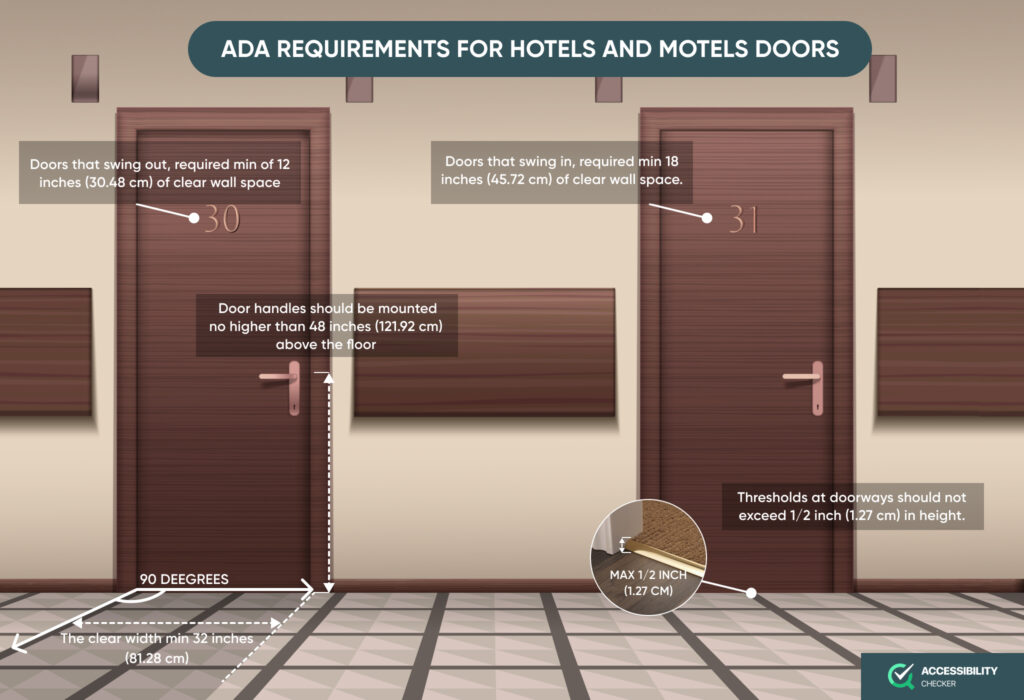
Hallways also factor into ADA requirements for hotels.
Wider hallways and adequate turning spaces are essential for people using wheelchairs, scooters, walkers, or other mobility devices.
Hallways with proper width and without protruding objects also help people with visual impairments avoid obstacles and navigate safely.
Let’s look at the specific requirements:
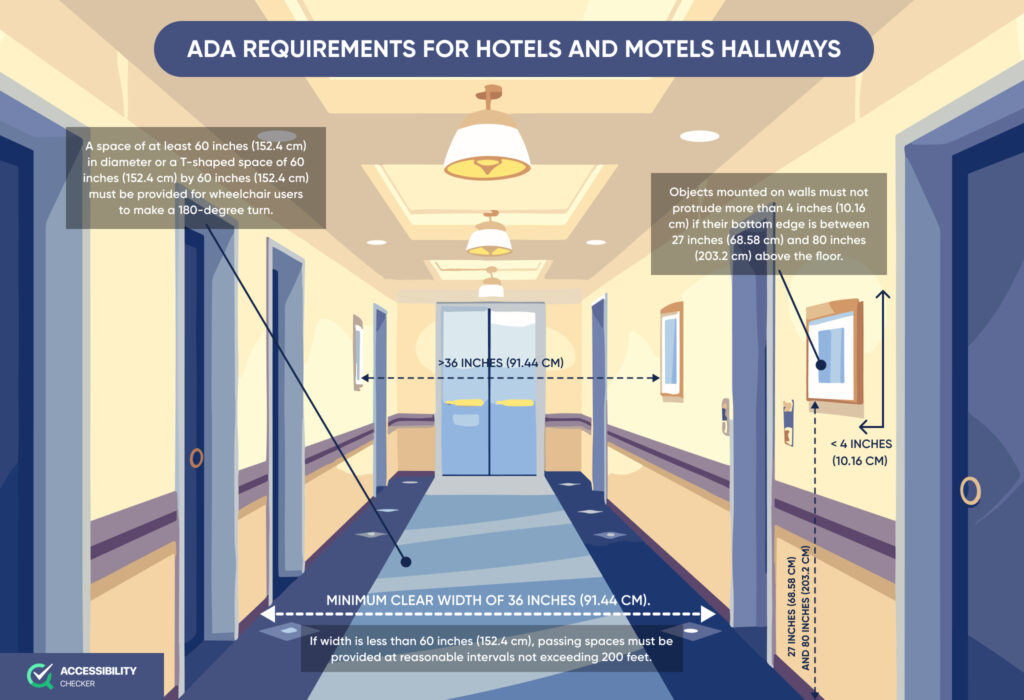
Accessible thresholds help people with various disabilities, including people who rely on mobility aids, guests with limited strength or dexterity in their hands or arms, and those with visual impairments.
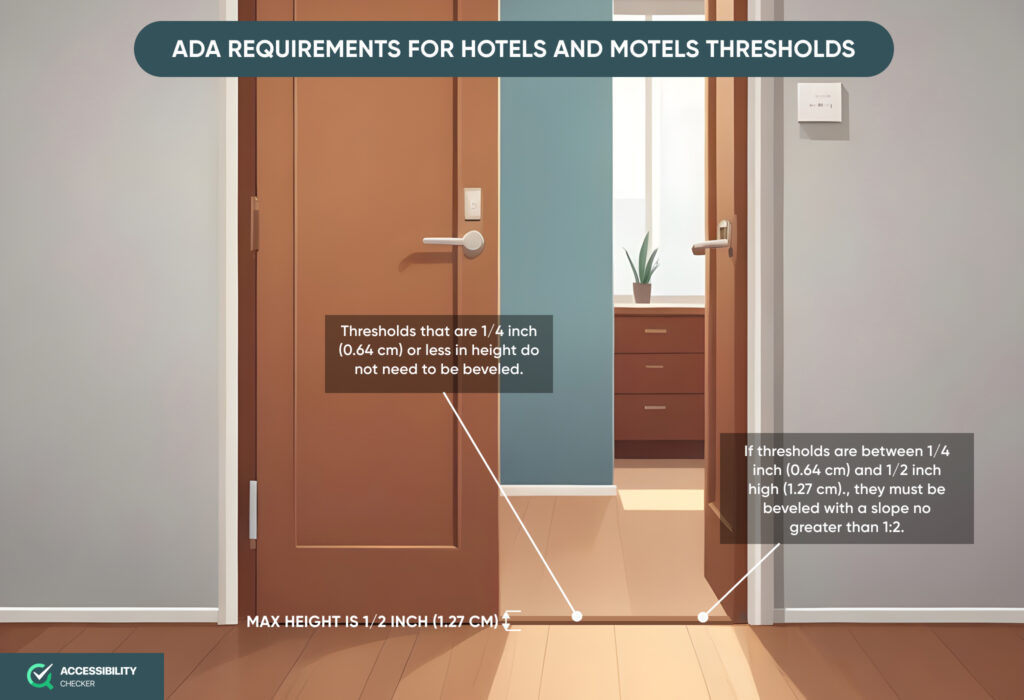
While the ADA does not specify exact height requirements for beds in hotels, it emphasizes the importance of accessibility for guests with disabilities.
The guidelines suggest that the height of a bed should allow for easy transfers from a wheelchair to the bed and vice versa. Based on general recommendations from accessibility experts and best practices, the top of the mattress should be between 17 (43.18 cm) to 23 inches (58.42 cm) from the floor.
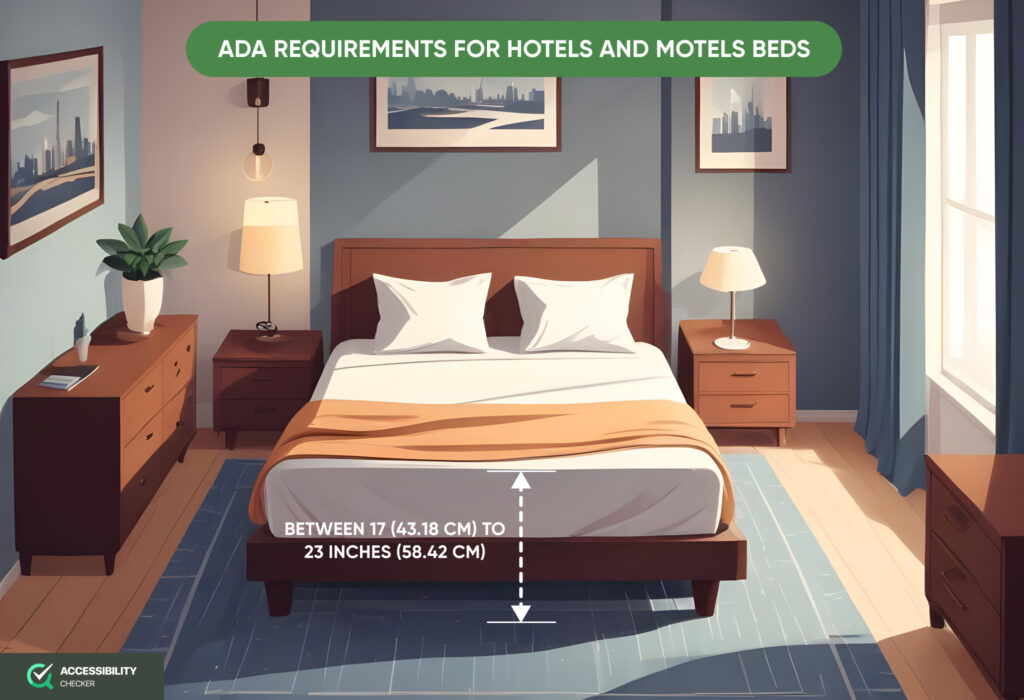
For lodging facilities that offer desks in rooms, there are certain ADA requirements that need to be met.
People using wheelchairs benefit from an appropriate desk height and adequate knee and toe clearance as it allows them to use the desk more comfortably.
When items on a desk are easier to reach, it also benefits people with limited hand and arm strength and dexterity.
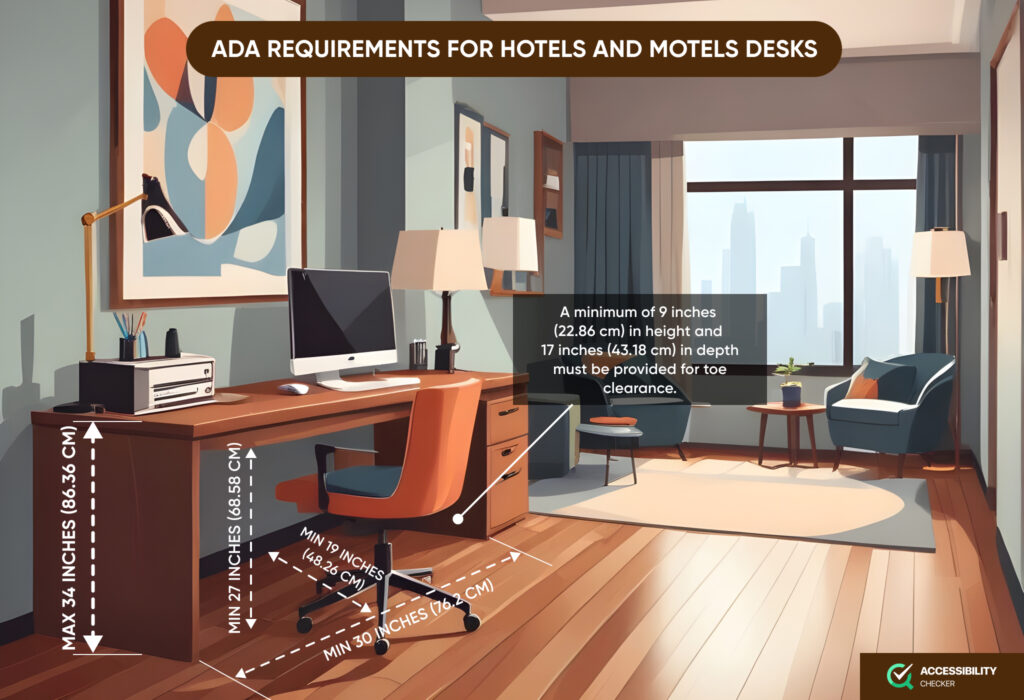
Even furniture layouts matter when it comes to hotels meeting the latest ADA requirements.
People with mobility, dexterity, visual, and balance impairments all benefit from a more accessible hotel room layout, ensuring they can enjoy a safe and unobstructed experience.
Here are some requirements to be aware of:
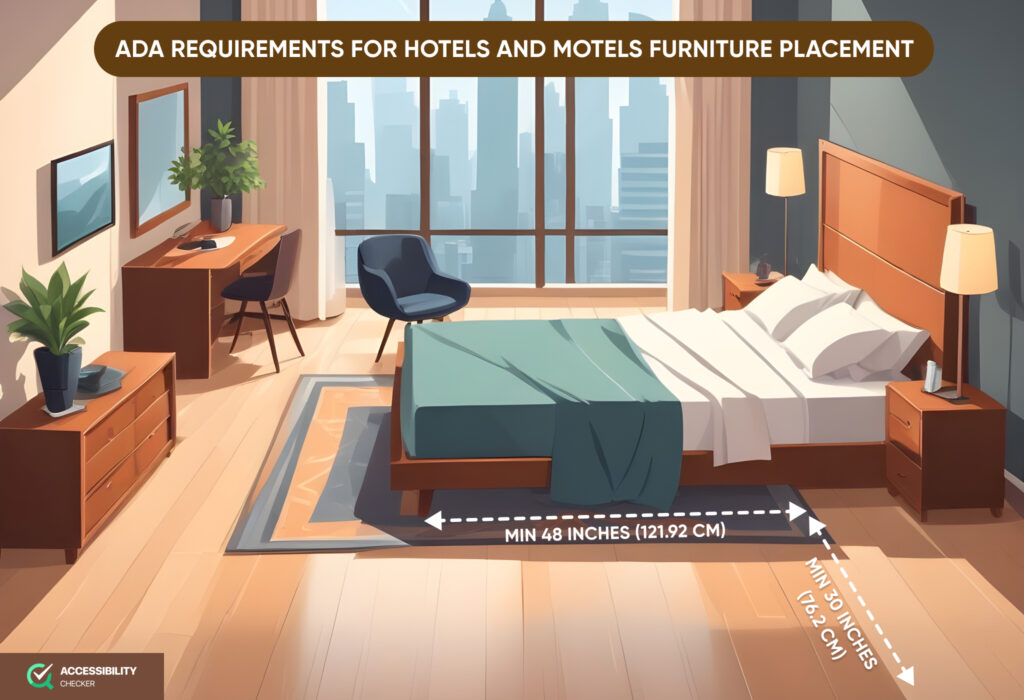
Bathrooms are an important amenity in any lodging facility, which is why stringent ADA requirements are in place.
People with mobility impairments need to use bathrooms that are easily accessible. This means that fixtures need to be at the right height and grab bars need to be installed for stability.
For guests with limited strength or dexterity in their hands or arms, lever handles, push-type faucets, and other accessible controls need to be in place.
Accessible bathrooms are even beneficial for elderly guests who have limited mobility and balance.
Let’s look at the specifics:
Toilets
Sinks
Showers and Bathtubs
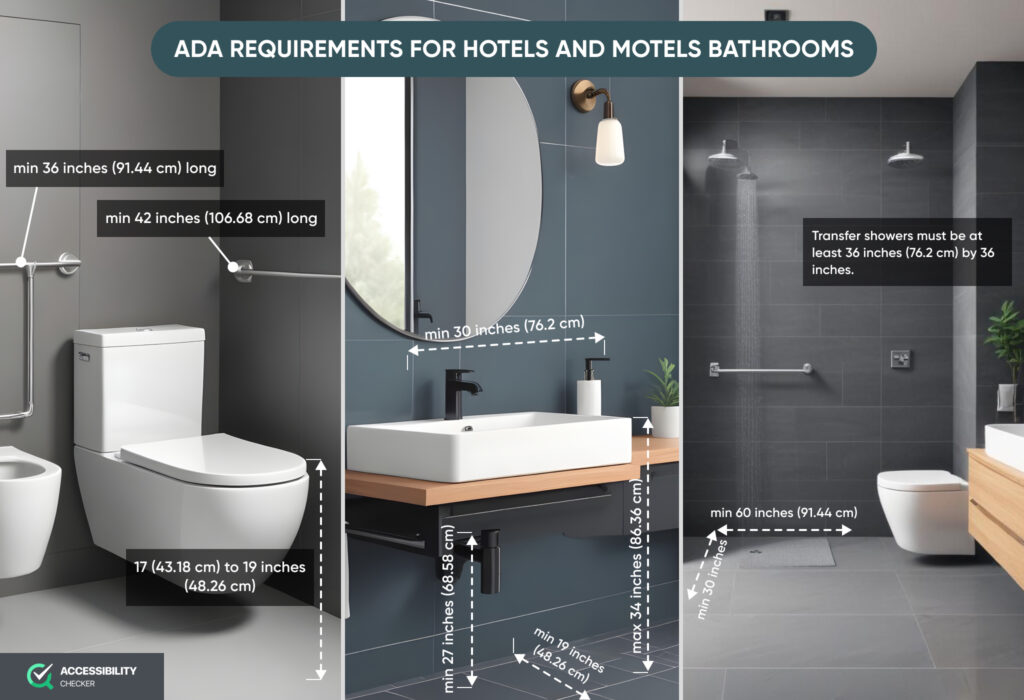
For hotels and motels that offer dining facilities, there are a few ADA requirements to be aware of in order to provide a more inclusive experience for guests.
Entrance and Access Routes
Seating
Service Counters
Restrooms
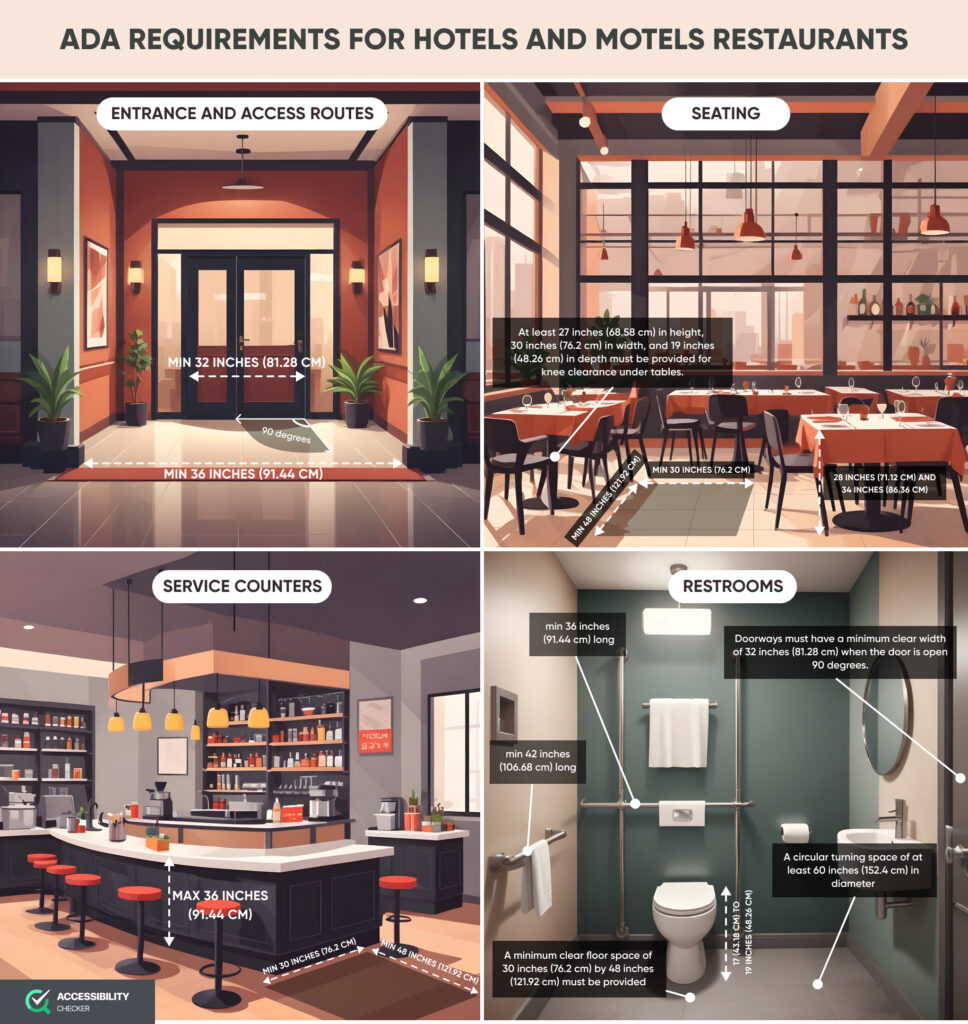
As much as your facilities need to cater to your disabled guests, so do your staff.
Here are a few things to consider:
Basic ADA Training
Educate staff on the fundamental principles and purpose of the ADA and the requirements for different areas of the hotel, including guest rooms, bathrooms, restaurants, common areas, parking lots, and entrances.
Customer Service Training
Train staff on how to communicate effectively with guests with disabilities, including those with visual, hearing, and speech impairments.
Emphasize the importance of respectful and inclusive language.
It’s also important to educate staff on how to offer assistance without being intrusive, such as asking if a guest needs help rather than assuming.
Demonstrate techniques for assisting guests with mobility impairments, including guiding visually impaired guests and helping wheelchair users navigate the facility.
Equipment and Technology Training
Ensure staff are knowledgeable about the hotel’s accessibility features, such as accessible rooms, bathrooms, lifts, and assistive listening devices.
It also helps to train staff on how to operate and assist guests with using accessible
Specialized Training
Offer specialized training for roles that may have more frequent interactions with guests with disabilities, such as front desk staff, concierges, and housekeeping.
Your guests are how you generate an income at your hotel or motel, so their experience is everything.
Lodging facilities that prioritize the needs of disabled guests not only comply with all the legal ADA requirements, but show their commitment to providing a more inclusive experience too.
Click here to download our ADA Requirements for Lodging Facilities Checklist.
The number of ADA-accessible rooms required in a hotel depends on the total number of rooms in the facility.
| Number of Hotel Rooms | Number of Accessible Rooms |
| 1 – 25 | 1 |
| 26 – 50 | 2 |
| 51 – 75 | 3 |
| 76 – 100 | 4 |
| 101 – 200 | 5 – 6 |
| 201 – 500 | 7 – 9 |
| 501 – 1000+ | 2% of total rooms |
Yes, hotel rooms are required to have wheelchair access according to the Americans with Disabilities Act. This ensures that people who use wheelchairs or other mobility aids can comfortably and safely access and use hotel rooms. The number of rooms that require wheelchair access depends on the total number of rooms in the facility.
It is not legally required for you to mention the ADA compliance status of your hotel on your website, but it can help you showcase your commitment to inclusivity. In terms of web accessibility, it’s highly recommended that you have an accessibility statement on your site that highlights the steps you have taken to make your website ADA compliant.